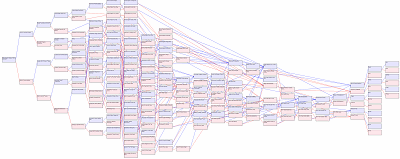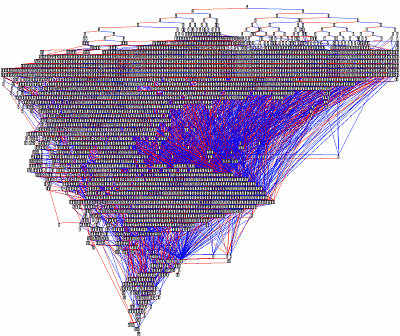Pedigree collapse
By Murray Bourne, 29 Jun 2015
Here's an interesting question to consider.
Each of us has 2 parents. They in turn had 2 parents, so there are 4 people in that generation to whom we are related.
Keep on going, and you will have 8 in the great-grandparents' cohort, 16 in the great-great-grandparents' group, and so on.
There's a problem - we can't have exponentially growing nunbers of ancestors forever. If we go back 30 generations (to around 1200 AD), we would have around 230 = 1,073,741,824 ancestors, which is more than the number of people in the world at the time. At some point, the number of ancestors needs to begin shrinking, so that we end up with our one common ancestor in the distant past.
So what's going on?

Ancestry of a duck tolling retriever
Of course, there are going to be overlaps. For example, my first cousin shares some of the same ancestors that I do (our grandparents are in common), and my second cousin and I share the same great grandparents. Every now and then, people marry someone who is closely related (either knowingly or otherwise) and the number of unique ancestors is reduced even more.
This was an issue for European royalty (especially Spain's), who considered their number of potential marriage partners to be quite limited, and so they happily married cousins, uncles, grandchildren and nieces.
The interesting question is: How far back do we need to go to run out of unique ancestors, considering everybody alive today?
It turns out this occurred around 1200AD when the maximum number of real ancestors was around 2 million, not one billion as we discussed earlier.
One of the great results from this article is that probably everyone alive is at least 50th cousin to everyone else.
So indeed, we are all one family...
Animal pedigrees
In an article about border collie ancestry, there are some interesting images depicting dog ancestry and pedigree collapse.
The author, Christopher, first presents this image of the first 10 sets of ancestors of his border collie Mercury.

By the time we get to the 80th generation, we see a distinctive diamond-shaped pedigree collapse:

This is similar to the first image in this article, which shows an interesting fish-shaped pedigree collapse pattern, for a duck tolling retriever dog.
Pedigree collapse is the result of inbreeding, an undesirable (when the relationship is too close), but inevitable feature of human and animal reproduction.
See the 4 Comments below.

2 Jul 2015 at 9:43 pm [Comment permalink]
The first time I've heard of this and then twice in as many days. http://www.xkcd.com/1545/
Quite interesting
12 Sep 2015 at 9:32 am [Comment permalink]
Christopher This topic believe goes in one ear and out the other of show breeders. Some seem to understand that having closely related parents doesn’t exactly ‘mess with your DNA’, as one could put it. But it does mean that you have less diversity, or variety, in your DNA. And diversity can be very important to a person's and their dog's health.
Less variety in your DNA or your dog's can increase chances of getting rare genetic diseases. You may have heard of some of these diseases: albinism, cystic fibrosis, hemophilia and so on.
Less variety in DNA can also make you or your dog unhealthy in another way – it can weaken the immune system making it impossible to fight off diseases as well. It can and does result in a sickly person or canine.
31 Oct 2015 at 2:42 am [Comment permalink]
When cousins born late 20th century compare DNA with a known 4rd cousin, the examination of DNA (by FTDNA or Ancestry.com DNA or 23andme) computes a CLOSER relationship. Why?
A woman born 1895 traces her pedigree back to 1557. Nine generations.
She discovers that she can trace her pedigree back to 1557 in seven different paths. Apparently , in many of the marriages, both the bride and the groom were descendants of the 1557 ancestor.
Due to the multiple cousin marriages in 17th and 18th centuries, the DNA contains an "overabundance" of the autosomal DNA of the 1557 ancestor.
And, this overabundance of 1557 DNA causes the prediction of FTDNA to be "2nd cousin".
In comparing autosomal DNA I note that the cM and number of points of comparison are greater
when both cousins share in a pedigree that includes multiple cousin marriages.
Where can I go for further discussion of the "skewing of autosomal results" ?
7 Jul 2016 at 4:58 pm [Comment permalink]
[…] For the mathematic take in simple terms(mostly) Murray Bourne explains it here. […]